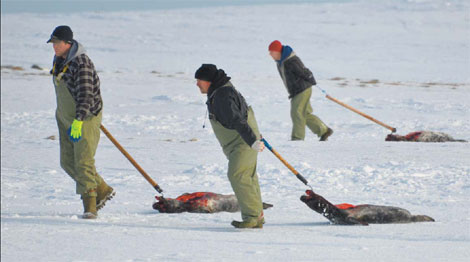Unsealing the deal
Updated: 2011-12-06 09:49
By Wang Ru (China Daily)
|
|||||||||
 |
|
Canadian sealers drag slaughtered seals across ice floes. Photos Provided to China Daily |
A grassroots revolt against Canadian seal products that led to a trade deal suspension portrays a shift in China's consumer conscience. Wang Ru reports.
As industries that allegedly practice animal cruelty have tried prying open the Chinese market, while they meet resistance in other countries, Chinese consumers are pushing back.
On Nov 19, Chinese conservationists and animal rights groups staged an awards ceremony for a poster-design competition oriented around protesting seal products. NGO representatives, professors and celebrities attended.
China Animal Protection Media Saloon founder Zhang Dan points to sales of seal products and the introduction of the United States rodeo as representatives of cruel to animal industries trying to expand in China.
"It's a trend that industries involved in animal cruelty look toward China's massive market potential as their sales slump elsewhere," Zhang says.
The Canadian newspaper The Globe and Mail quotes seal-oil supplement manufacturer DPA Industries' chairman Wayne MacKinnon as saying, "The Chinese eat anything. And they simply don't understand why you would put one animal above another."
Other foreign reports say the Chinese have no regard for animal welfare and no relevant legislation.
"Because of prejudice, they believe most Chinese don't care about animals and eat anything," Zhang says.
"But they're perfectly wrong."
The Chinese government announced in 2010 the suspension for further review of a trade deal to import Canadian seal products.
Pressure from animal rights groups led to the indefinite postponement of the rodeo scheduled for Oct 1 at Beijing's Bird's Nest.
But seals have become the movement's current focus.
A seal looks at another seal's skinned body.
 |
|
A seal looks at another seal's skinned body. |
The recent award ceremony featured a film by the event's organizer, the NGO Green Beagle, showing commercial seal hunting on the Canadian ice floes. The film showed the slaughter of mature seals and their pups with rifles and heavy wooden clubs topped with hammerheads called "hakapiks".
The bloody footage was shot by Rebecca Aldworth, executive director of the Humane Society International Canada (HSI Canada), who also joined the Beijing event.
Aldworth has spent the past decade observing Canada's commercial seal hunts firsthand. She has escorted more than 100 scientists, parliamentarians and journalists to the ice floes to witness the slaughter.
"The attitude of Chinese consumers is crucial," Aldworth says.
"Now, you have the opportunity to terminate the massacre of seal pups in Canada. You are at a crossroads to open to the dying cruel industry, or stand with other countries to ban the seal products."
More than 30 countries and regions, including the United States, the European Union and Russia, have banned imports of Canadian seal products.
"We've endeavored to protect the spotted seals in China and have won support from our government," Tian says.
"The import of seal products from other countries won't work in China."
Canada's controversial seal hunting industry has been in decline because of international pressure.
The number of harp seals slaughtered in the spring of 2011 in Canada was about 37,917 - less than 10 percent of the 400,000 quota.
The slump is partly because of the 2009 EU ban on imports but is also because the ice in the Gulf of St Lawrence off Canada's eastern coast is thinner and less stable.
The industry is small in Canada and generates between $10 million and $20 million a year.
But it's politically sensitive, because many of the 6,000 remaining seal hunters are from Inuit communities, which have hunted the mammal for centuries and perhaps millennia.
In September 2010, the European General Court rejected a bid by Canada's largest Inuit organization to challenge the EU's ban on seal products.
The Canadian government recognizes that thin ice - climatically and politically - has caused the harvests to decrease by about 75 percent over the past five years to 70,000.
The market price for pelts has fallen, too.
The China Chamber of International Commerce staged a March 28 seminar on the seal trade.
HIS' China policy consultant Li Jianqiang said the Canadian government had "rushed" to release the "good news" about the trade deal with China to enable politicians to win votes.
"We know that China is a huge potential market," Gail Shea, then Canada's minister of fisheries and oceans, said during a trip to China in January 2010.
During this year's visit, Shea promoted seal-fur products at the 37th China Fur and Leather Products Fair.
About 40 animal rights groups responded to her actions with a protest letter.
One activist attended the fair with a banner pinned to his back that read: "Chinese people do not welcome Canadian seal products!"
But despite activists' objections to seal products, oil, hats and wallets made from the animals are still sold on China's largest online shopping website, Taobao. A seal leather belt costs from $100 to $220.











